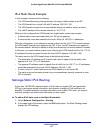
130
4
4. Firewall Protection
This chapter describes how to use the firewall features of the VPN firewall to protect your
network. The chapter contains the following sections:
• About Firewall Protection
• Overview of Rules to Block or Allow Specific Kinds of T
raffic
• Configure LAN WAN Rules
• Configure DMZ WAN Rules
• Configure LAN DMZ Rules
• Examples of Firewall Rules
• Configure Other Firewall Features
• Services, Bandwidth Profiles, and QoS Profiles
• Configure Content Filtering
• Set a Schedule to Block or Allow Specific Traffic
• Enable Source MAC Filtering
• Set Up IP/MAC Bindings
• Configure Port Triggering
• Configure Universal Plug and Play
About Firewall Protection
A firewall protects one network (the trusted network, such as your LAN) from another (the
untrusted network, such as the Internet), while allowing communication between the two.
You can further segment keyword blocking to certain known groups. For information about
how to set up LAN groups, see Manage IPv4 Groups and Hosts (IPv4 LAN Groups) on
page 91.
For IPv4, a firewall incorporates the functions of a Network Address T
ranslation (NAT) router,
protects the trusted network from hacker intrusions or attacks, and controls the types of
traffic that can flow between the Internet, DMZ, and LAN. Unlike simple NAT routers, a
firewall uses a process called stateful packet inspection to protect your network from attacks
and intrusions. NAT performs a limited stateful inspection in that it considers whether the


















